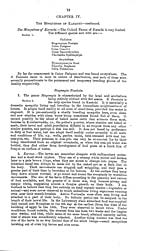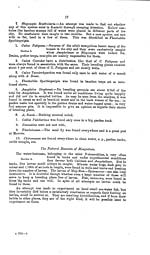Medicine - Disease > Report of an investigation in regard to the prevalence of stegomyia and other mosquitoes in Karachi, and the measures necessary for their control
(34) Page 16
Download files
Individual page:
Thumbnail gallery: Grid view | List view

16
3. The Nymphae are not so dark as those of C. Fatigans; the trumpets are expanded and broadly triangular in shape. They hatch out within 2 to 4 days invariably and never more.
4. The Imago varies in size from 2.5 to 4 m.m., the smaller size predominating. Their colour for a day or two of their emergence is bright red on the thorax, with white bright lines. Of these there are two median parallel pale lines, and two curved silvery ones, one on each side and a small line in front between the two median ones. The legs are banded and on account of their striped appearance they are known as tiger mosquitoes. The colour gradually darkens to reddish brown, though it is never so dark as it is in Bombay. They bite viciously during the day from 11 a.m. to 3 p.m., and the bite is very irritating. I have never found S. Fasciata to become a nocturnal feeder after its first blood meal. Dark clothing attracts them most. Adult S Fasciata were almost always caught inside the houses and out-houses, but never outside or in gardens. The males are more delicate in structure and smaller in size and from any particular sample more males than females hatched out.
5. The eggs are ovoid, pointed at one end and rounded at the other, and are surrounded by a series of little air chambers. They adhere to the sides of the vessel or to the material on which they are laid, and are difficult to remove.
6. Life History.-The following points in their life history were noted. Three series of cage experiments on isolated couples were done; (the cages used were 1 cubit feet in size, were made of wooden frames with fine cloth gauze stuck all round. They were well protected from spiders or ants. The mosquitoes were fed on black raisins, and a dish of water with pieces of pith floating was kept in).
In the 1st series, where no feed of blood was given, no egg-laying was ever seen, though mating was often noticed.
In the 2nd series, the couples were fed on blood on the first day of their emergence, and subsequent feeds were given ten days after the last batch of eggs was laid. This period was allowed to elapse in order to observe whether one feed of blood was sufficient for the egg-laying function for all their life. Copulation was not seen earlier than on the third day, and on the sixth day or later, the first batch of eggs was laid, the number of eggs varying from 24 to 44; in a few cases a second and a third batch of 8 to 12 eggs was laid in two or three days more. Similar results were noted after the 2nd and 3rd feed of blood; but the female never outlived the 3rd egg-laying period, the maximum number of eggs laid during the lifetime of one female being 64.
In the 3rd series, it was attempted to give the female frequent feeds of blood. In the majority of cases she refused to bite and the results in no way differed from that of the second series.
The males died off earlier than the females, 12 days being the maximum period of their lifetime. New males were always supplied. The female lived from four to five weeks.
The eggs were laid singly during the night time and some of them immediately sank though an almost perfect rim of floats could be seen around them. 25 per cent. of them hatched out during the first 24 hours ; but even after three days 20 per cent. still remained unhatched. These unhatched eggs, after remaining in water for a fortnight, were dried and a few days later were placed under suitable conditions for hatching. Out of these only a few hatched out at different times during these three months, but the others, 8 per cent., are still just the same. Whether they are unfertilized eggs, or some form of resistent eggs, I cannot say. Another batch of eggs, which were dried soon after being laid, were after three months placed under suitable conditions and these hatched out with the above reservations.
No statement can be made as regards the seasonal variation of S. Fasciata in the same locality, nor of their prevalence in different parts of the city at any one particular period.
3. The Nymphae are not so dark as those of C. Fatigans; the trumpets are expanded and broadly triangular in shape. They hatch out within 2 to 4 days invariably and never more.
4. The Imago varies in size from 2.5 to 4 m.m., the smaller size predominating. Their colour for a day or two of their emergence is bright red on the thorax, with white bright lines. Of these there are two median parallel pale lines, and two curved silvery ones, one on each side and a small line in front between the two median ones. The legs are banded and on account of their striped appearance they are known as tiger mosquitoes. The colour gradually darkens to reddish brown, though it is never so dark as it is in Bombay. They bite viciously during the day from 11 a.m. to 3 p.m., and the bite is very irritating. I have never found S. Fasciata to become a nocturnal feeder after its first blood meal. Dark clothing attracts them most. Adult S Fasciata were almost always caught inside the houses and out-houses, but never outside or in gardens. The males are more delicate in structure and smaller in size and from any particular sample more males than females hatched out.
5. The eggs are ovoid, pointed at one end and rounded at the other, and are surrounded by a series of little air chambers. They adhere to the sides of the vessel or to the material on which they are laid, and are difficult to remove.
6. Life History.-The following points in their life history were noted. Three series of cage experiments on isolated couples were done; (the cages used were 1 cubit feet in size, were made of wooden frames with fine cloth gauze stuck all round. They were well protected from spiders or ants. The mosquitoes were fed on black raisins, and a dish of water with pieces of pith floating was kept in).
In the 1st series, where no feed of blood was given, no egg-laying was ever seen, though mating was often noticed.
In the 2nd series, the couples were fed on blood on the first day of their emergence, and subsequent feeds were given ten days after the last batch of eggs was laid. This period was allowed to elapse in order to observe whether one feed of blood was sufficient for the egg-laying function for all their life. Copulation was not seen earlier than on the third day, and on the sixth day or later, the first batch of eggs was laid, the number of eggs varying from 24 to 44; in a few cases a second and a third batch of 8 to 12 eggs was laid in two or three days more. Similar results were noted after the 2nd and 3rd feed of blood; but the female never outlived the 3rd egg-laying period, the maximum number of eggs laid during the lifetime of one female being 64.
In the 3rd series, it was attempted to give the female frequent feeds of blood. In the majority of cases she refused to bite and the results in no way differed from that of the second series.
The males died off earlier than the females, 12 days being the maximum period of their lifetime. New males were always supplied. The female lived from four to five weeks.
The eggs were laid singly during the night time and some of them immediately sank though an almost perfect rim of floats could be seen around them. 25 per cent. of them hatched out during the first 24 hours ; but even after three days 20 per cent. still remained unhatched. These unhatched eggs, after remaining in water for a fortnight, were dried and a few days later were placed under suitable conditions for hatching. Out of these only a few hatched out at different times during these three months, but the others, 8 per cent., are still just the same. Whether they are unfertilized eggs, or some form of resistent eggs, I cannot say. Another batch of eggs, which were dried soon after being laid, were after three months placed under suitable conditions and these hatched out with the above reservations.
No statement can be made as regards the seasonal variation of S. Fasciata in the same locality, nor of their prevalence in different parts of the city at any one particular period.
Set display mode to: Large image | Zoom image | Transcription
Images and transcriptions on this page, including medium image downloads, may be used under the Creative Commons Attribution 4.0 International Licence unless otherwise stated. ![]()
| Permanent URL | https://digital.nls.uk/74572958 |
|---|




